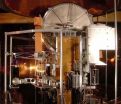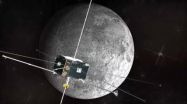Probing the mysterious second-wave of damage in head injury patients
2010-10-28
(Press-News.org) Why do some of the one million people who sustain head injuries annually in United States experience a mysterious second wave of brain damage days after the initial injury — just when they appear to be recovering? Limited clinical trials using an innovative new device to monitor brain chemistry on a second-by-second basis are underway to answer that life-and-death question, according to an article in the current issue of Chemical & Engineering News (C&EN), ACS' weekly newsmagazine. Brain injury is the leading cause of death and disability worldwide.
C&EN Senior Editor Celia Henry Arnaud describes a phenomenon called depolarization, in which brain activity decreases in patients following initial trauma. The condition involves a wave of chemical changes that spread from the site of injury and inactivate nerve cells. Since reactivation of these cells requires large amounts of glucose, monitoring glucose levels in a patient's brain can help doctors tell whether or not a patient is taking a turn for the worse. The article points out that a promising new device could provide a faster and more useful way to monitor brain glucose than current methods, which are inefficient.
Now in development at Imperial College London, the new so-called "microfluidic method" measures glucose quickly and continuously — in fractions of a second instead of hourly. The device is currently being tested in patients who have suffered trauma, stroke, or aneurysm (a balloon-like enlargement of a brain artery). In the future, the device could be used in patients with milder forms of brain injury and used in a way that is less invasive, the article notes.
INFORMATION:
ARTICLE FOR IMMEDIATE RELEASE
"Brain Glucose, Drop By Drop"
This story is available at
http://pubs.acs.org/cen/science/88/8843sci2.html
END
ELSE PRESS RELEASES FROM THIS DATE:
2010-10-28
Scientists are calling for more research on the possibility that some supposedly healthful plant-based antioxidants — including those renowned for their apparent ability to prevent cancer — may actually aggravate or even cause cancer in some individuals. Their recommendation follows a study in which two such antioxidants — quercetin and ferulic acid — appeared to aggravate kidney cancer in severely diabetic laboratory rats. The study appears in ACS' bi-weekly Journal of Agricultural and Food Chemistry.
Kuan-Chou Chen, Robert Peng, and colleagues note that vegetables, ...
2010-10-28
Extending its 26-year tradition of innovative quantum voltage standards, researchers at the National Institute of Standards and Technology (NIST) have begun shipping a new 10-volt standard to users around the world. The programmable system measures both direct current (DC) and alternating current (AC) voltages.
NIST AC/DC 10-volt standard chip.
The new 10-volt system* builds on a number of previous NIST inventions, from the initial 1-volt standard in 1984 through the 2006 unveiling of the world's first precision instrument for directly measuring AC voltages.** Because ...
2010-10-28
Better psychological and spiritual support, improved planning of care and stronger relationships with physicians are necessary to improve end-of-life care in Canada, according to a study by a Queen's University professor.
"High quality end-of-life care should be the right of every Canadian," says professor of Medicine and Epidemiology Daren Heyland, who is also a researcher at Kingston General Hospital. "But it's not always happening. We know from international studies that Canada ranks ninth in the world in terms of quality of care provided at the end of life."
The study, ...
2010-10-28
Taking the first steps of what would be a major historical advance in the science of measurement, the National Institute of Standards and Technology (NIST) is participating in a worldwide effort to recommend major revisions to the International System of Units (SI), the modern metric system that is the basis of global measurements in commerce, science and other aspects of everyday life. The new SI, which would be based on seven constants of nature, would enable researchers around the world to express the results of measurements at new levels of consistency and accuracy.
The ...
2010-10-28
Cockroaches can skitter through a crowded under-the-sink cabinet, eluding capture or worse, making the insects a model for rescue robots that would creep through the debris of disaster in search of survivors.
But learning how they use all six legs at the same time to walk, run and turn has been a difficult and time-consuming task. Until now.
Using a pair of high-speed cameras and a custom computer program, researchers at Case Western Reserve University are able to simultaneously extract three-dimensional movement of a cockroach's 26 leg joints. They report their findings ...
2010-10-28
Texas A&M University is one of 10 international partners involved in the global conservation study and subsequent scientific paper, "The Impact of Conservation on the Status of the World's Vertebrates," that is scheduled to be published in Science, the academic journal of the American Association for the Advancement of Science.
Dr. Thomas E. Lacher, Jr., Texas A&M University's wildlife and fisheries sciences department head at College Station, Texas and a coauthor, said the report reviews the current status of thousands of species in light of the 2010 target of the Convention ...
2010-10-28
Two micro-satellites originally launched into Earth's orbit in 2007 by NASA have been redirected by University of California, Berkeley, scientists toward new orbits around the moon, extending study of the earth and moon's interaction with the solar wind.
The second of the two probes settled into a temporary "Lagrange-point" orbit on Friday, Oct. 22, inaugurating science operations for a new mission dubbed ARTEMIS – Acceleration, Reconnection, Turbulence, and Electrodynamics of the Moon's Interaction with the Sun.
Lagrange points are places where the gravity of Earth ...
2010-10-28
Researchers at North Carolina State University have found that the overproduction of a key protein in stem cells causes those stem cells to form cancerous tumors. Their work may lead to new treatments for a variety of cancers.
Dr. Jon Horowitz, associate professor of molecular biomedical sciences, and a team of NC State researchers looked at the protein SP2, which regulates the activity of other genes. They knew that elevated amounts of SP2 had been observed in human prostate-cancer patients, and that these levels only increased as the tumors became more dangerous. They ...
2010-10-28
DURHAM, N.C. – A doubling of abnormally wet or dry summer weather in the southeastern United States in recent decades has come from an intensification of the summertime North Atlantic Subtropical High (NASH), or "Bermuda High."
And that intensification appears to be coming from global warming, according to a new analysis by a Duke University-led team of climate scientists.
The NASH is an area of high pressure that forms each summer near Bermuda, where its powerful surface center helps steer Atlantic hurricanes and plays a major role in shaping weather in the eastern ...
2010-10-28
Pediatric researchers at The Children's Hospital of Philadelphia describe a successful program in which nurses helped mothers attain high rates of breast-feeding in very sick babies--newborns with complex birth defects requiring surgery and intensive care.
Many of these highly vulnerable newborns immediately experience a paradoxical situation. Their mother's milk helps to fend off infection and provides easily digestible, nutritious ingredients that can reduce the infant's stay in the neonatal intensive care unit (NICU). But because the babies are often in critical condition, ...
LAST 30 PRESS RELEASES:
[Press-News.org] Probing the mysterious second-wave of damage in head injury patients


